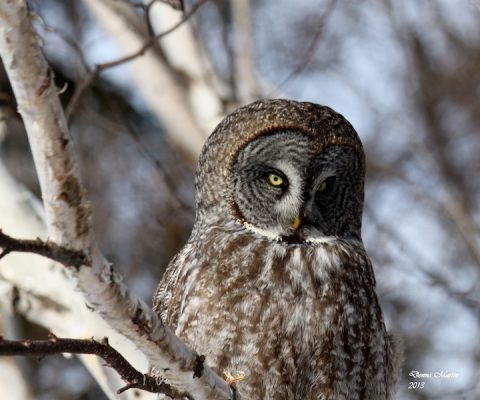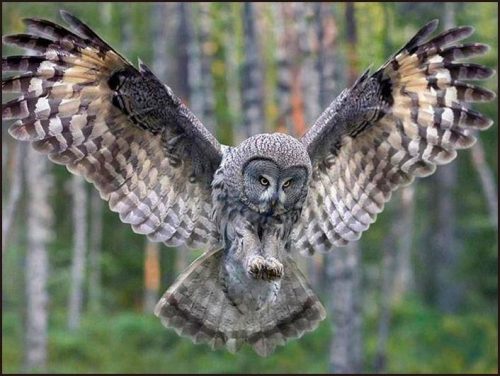The great grey owl (Strix nebulosa) is the largest of the forest owls. It is thought to occupy the coniferous forests of North America. The owl is highly aggressive; actively defends nest and it mainly feeds on voles. Great grey owl is able to detect little movements of a vole (beneath the snow) hundreds of yards away. It is probably the largest owl species in length.
Great Grey Owl Facts
Anatomy
- Adult great grey owl averages 61 to 84 cm (24 to 33 in) with males reaching 72 cm (28 in) and females grow about 67 cm (26 in) in length.
- They have a wingspan measuring up to 152 cm (60 in).
- Males typically weigh up to 1,290 g (2.84 lb) while females averaging 1,000 g (2.2 lb).
- Great grey owl has got the tail longest of any living owl.
- The owl’s body is all covered with fluffy feathers. Yellow eyes are set in the middle of a rounded disc. The head is round and there are dark circles around the eyes.
- Like typical owls, females are larger than the males.
- They have large ear openings which allow the owl to listen to the minute movements of a vole under the thick blanket of ice.
- There are two toes on the front two on the back of feet. It all combines to have a firm grip with pin-sharp talons. Prey is least likely to escape once the bird gets hold of it.
- Hatchlings are recognized by white down.
Read More: Ultimate Guide to the Owl’s Diet

Geographic Range
- Great grey owls mainly occur in the North America including central Alaska, Ontario, Montana, and Pacific coast but it is also thought to exist in Quebec. They are likely to breed throughout northern Asia, Finland, and Estonia.
- Great grey owls are not migratory but when the food is scarce they do move to the south or southeast.
- An isolated population is also found in California where it lives in the Sierra Nevada Mountains.
- Great grey owls breed in large numbers in Norway, Sweden, and Russia.
Habitat
- They will find homes in mature coniferous forests of North America. The owl’s habitat includes vast belt of boreal forests that goes from Finland all the way to Siberia.
- Great grey owls typically live in the cold dark forests—land of which is covered with snow half year round.
- In summer they will hunt in open icy tundra.
Behavior
- Great grey owls are primarily solitary except at the breeding season when the pair produces a booming call to attract a mate.
- However solitary they may be, great grey owls will congregate in large numbers where voles are abundant.
- It is thought to migrate particularly when the temperature in Siberian taiga falls below minus 76o
- The owl actively defends its nest against any intruder may in swoop in attack.
- They will produce pig-like grunt especially when parents guards the nest.
- If provoked great grey owls are not scared to attack humans who intend to get too close to the nest.

Feeding Ecology & Diet
- Great grey owls will come out to hunt in dawn and in the twilight hours. The owl rarely soars to find prey and mostly it rests on a perch while relying on the acute hearing sense to detect prey.
- They are able to detect the movement 300 yards away from the source. Moments later great grey owl makes a remarkable silent flight to capture the prey animal.
- Thanks to its acute hearing sense as it allows the owl to locate prey moving as deep as 2 feet beneath the snow.
- Great grey owl’s diet consists of small rodents particularly voles. They are known to eat thrushes, ducks, hares, weasels, voles, small hawks, grouse, moles, grey jays, and shrews.
Learn more: What do Owls Eat
Reproductive Biology
- They mainly breed in March to May.
- The mating occurs in the early spring. Great grey owl mostly uses nest that are abandoned by other birds like buzzards or goshawk.
- A female owl lays up to 6 eggs (9 eggs max.) with the interval of 2 days. She alone incubates the white eggs that last about 4 weeks while the male goes out to bring her food.
- Each of the eggs measure around 7 mm (1.68 in) in width with the length reaching at 53.5 mm (2.11 in).
- Both parents attain maturity at 2 years age.
- Baby owls are called ‘owlets’ and they leave the nest in 21 days. They remain with parents for about 60 days after which young owls disperse.
- Young owls may take their first flight within 63 days.
- The average lifespan of great grey owls is 7 – 10 years.
- They have got only a few natural predators. Some of them include great horned owls and black bears that prey on young owls.
Conservation Status
Least Concern
Learn more: What do Owls Eat


Leave a Reply